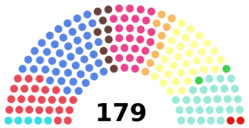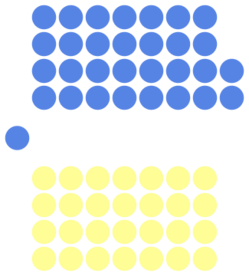Federal Diet (Erishlands): Difference between revisions
(Initial post - Basic infobox & Overview) |
mNo edit summary |
||
| Line 1: | Line 1: | ||
{{WIP}} | {{WIP}} | ||
{{Region_icon_Ajax}} | {{Region_icon_Ajax}} | ||
{{Infobox legislature | {{Infobox legislature | ||
Revision as of 21:00, 6 December 2020
This article is incomplete because it is pending further input from participants, or it is a work-in-progress by one author. Please comment on this article's talk page to share your input, comments and questions. Note: To contribute to this article, you may need to seek help from the author(s) of this page. |
Rikthing Ríkþinged | |
|---|---|
| Type | |
| Type | |
| Houses | Landething Folkthing |
| History | |
| Founded | 3 January 1833 |
| Leadership | |
Speaker of the Landething | Þórsten Wang, Democratic since 3 January 2020 |
President of the Folkthing | Ulle Næsz, Democratic since 3 January 2020 |
| Structure | |
| Seats | 238 (179 Representatives; 59 Senators) |
 | |
Landething political groups | Government (68)
Opposition (59)
Independents (51)
|
 | |
Folkthing political groups | Government (31)
Opposition (28)
|
| Elections | |
Landething voting system | Closed list proportional representation |
Folkthing voting system | Two-party proportional runoff |
Last election | 20 December 2019 |
Next election | 19 December 2023 |
| Meeting place | |
| Rikthing House Serstead Erishland | |
The Rikthing (Erish: Ríkþinged [ˌriːt͡ʃˈs̪ɪŋːl̩], "the realm assembly") is the bicameral federal parliament of Erishland, consisting of the Landething (Landeþinged) and the Folkthing (Folkþinged). The two houses are generally not referred to as "upper" and "lower" houses respectively, but as "legislative" and "executive" houses due to each's powers and relationship with the Cabinet. The two houses meet in the Rikthing House in Serstead, the capital city. All members of both houses are elected every four years.
The Landething consists of 179 Representatives. All of them are elected by closed list proportional representation, with 135 seats elected through a proportional election in each of the 6 Lands (which receive their seats by degressive apportionment), and the remaining 44 being compensatory. As a consequence of the system, multiple parties regularly attain representation, with the current Landething seating 10 different parties. Since 1897, no governing party has ever held a majority in the Landething, necessitating them negotiating with other parties to get legislation passed.
The Folkthing consists of 59 Senators, all of whom are elected through a national proportional runoff vote that progressively eliminates the weakest parties until two are left. At the national level during the past century, the two parties which receive Folkthing seats have traditionally been the center-left Democratic Party and center-right Realm Party (the Center has won the minority of seats a few times). As the Folkthing is the sole house the Royal Cabinet is responsible to, this has meant that the governing party always has a majority in the house.
The Rikthing has its roots in the Landrad, which was first convened in 1609 by Queen Ljosne I as an assembly with nobles from each of the Lands to advise her on the governance of the realm. During the late 1700s, seats of the Rikthing gradually began to take on legislative powers and be democratically elected, until, by 1831, the majority of seats were elected. Following the Republican Revolts, the monarchy was forced into creating the Rikthing, whose powers were extensive enough to establish parliamentary democracy. In 1909, the Rikthing took its contemporary form with the adoption of the modern election systems in both houses, and the abolition of the Folkthing's absolute veto and of appointed seats in the Landething.